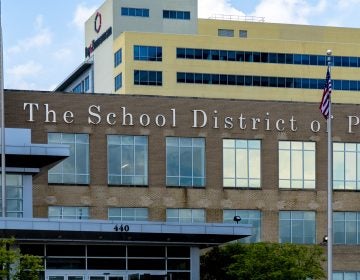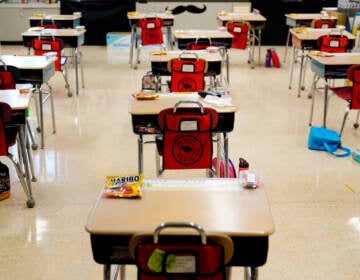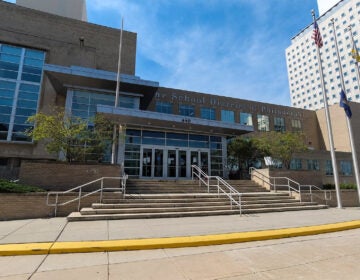Playbook for reopening schools: CHOP calls for face shields, staggered schedules, temp checks
Some may question the value of closing schools, but there’s plenty to be cautious about. According to one expert: “Lack of evidence doesn’t mean that there isn’t a risk.”
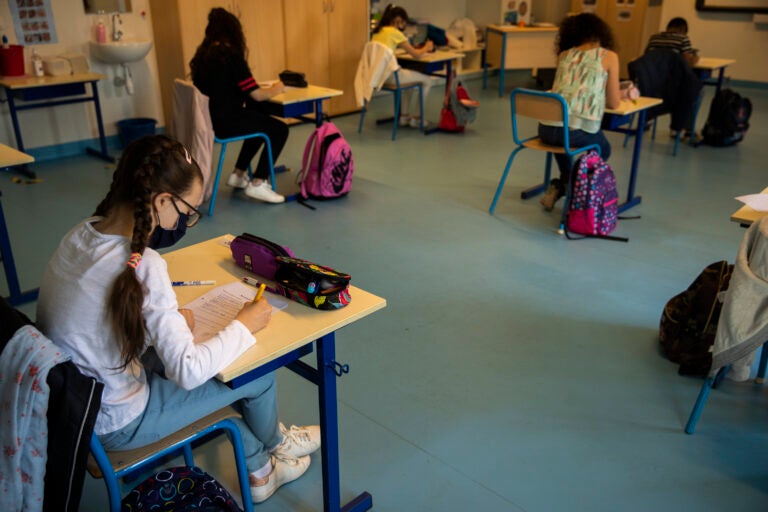
Students, wearing face masks and paying attention to social distancing, study at Les Magnolias primary school during the partial lifting of coronavirus, COVID-19, lockdown regulations in Brussels, Monday, May 18, 2020. (AP Photo/Francisco Seco)
Are you on the front lines of the coronavirus? Help us report on the pandemic.
If Pennsylvania schools reopen their doors this fall, local health experts expect they’ll look quite different than they did before the coronavirus pandemic.
Just how different?
A new policy review from the Children’s Hospital of Philadelphia (CHOP) — whose researchers have been advising state leaders during the outbreak — provides an eye-opening glimpse.
Here are just a few of the safety recommendations:
- Hold classes in gyms or outdoors
- Open windows for ventilation
- Give protective face shields to adults
- Create staggered schedules where students attend in-person or online depending on the day
- Start the school year earlier in case the virus reemerges in the winter
- Reduce class sizes to 10 or 15 students
- Conduct regular temperature checks and other types of “symptom surveillance” to ensure sick kids stay home
Are these measures overkill? Insufficient?
Based on what researchers know about transmission, it’s hard to gauge.
Scientifically, there’s no clear consensus yet on the effectiveness of school closures in stopping the spread of COVID-19. In the absence of consensus, there is debate.
From U.S. Sen. Rand Paul to Pennsylvania House Speaker Mike Turzai, many Republicans are calling for a more aggressive plan to reopen schools. Turzai (R-Allegheny) went as far to say that children aren’t at risk for COVID-19 unless they have an underlying medical issue, a claim Politifact rated as “false.”
Others, like leading national disease expert Dr. Anthony Fauci, preach caution, warning that there’s much we don’t yet know about this virus and pointing to emerging evidence of a strange, virus-related disorder attacking young children.
The discord has left school leaders clamoring for more guidance as they look cautiously toward the fall. That’s where recommendations from CHOP and other organizations could play a key role in shaping the public conversation.
To understand the context behind these various guidelines, it helps to go back to basics.
Why did we close schools at all?
Short answer: historical precedent.
Evidence from the 1918 flu pandemic suggests cities that closed their schools early and for long periods fared better than their counterparts. St. Louis — the oft-cited standard from that era for viral suppression — closed its schools for 143 days.
But you don’t need to rewind the clock that far for evidence of effectiveness, says Dr. Esther Chernak, an infectious disease expert at Drexel University in Philadelphia. Studies of more recent influenza pandemics — in 1957, 1968 and 2009 — led scientists to believe that schools can accelerate disease spread.
Even the seasonal flu seems to be driven by schools. Flu peaks tend to be less dramatic when they overlap with winter break, said David Rubin, director of the Policy Lab at Children’s Hospital of Philadelphia and co-author of the new memo.
The logic is clear. Kids go to school, swap germs and the virus rages.
That’s why “the first impulse with this pandemic was to close schools, thinking that perhaps children are important drivers of community-wide transmission,” said Chernak.
So, did it work?
Short answer: Well…
There are many complicating variables here, experts say.
For starters, school closures happened simultaneously with lots of other public health measures.
“Disentangling which of your moves actually produced the most value is really challenging because they all happened at the same time,” said Rubin.
Then there’s the specific pathology of SARS-CoV-2, the virus at the heart of the outbreak.
It’s clear the virus does not kill or sicken children at the same rate as adults — particularly the elderly. That doesn’t mean children can’t spread the virus among each other, and then eventually to their older relatives.
There’s clear evidence that asymptomatic carriers play a critical role in spreading SARS-CoV-2, says Nina Bharti, a biology professor at Penn State University and a member of the Center of Infectious Disease Dynamics. So the low illness rate among children doesn’t mean it’s safe to congregate them in small buildings.
“[Children] do get infected and they do transmit,” said Bharti. “That’s part of why we’re worried about their role in community-level transmission.”
One recent study found that children carry a “viral load” similar to adults, suggesting they’re quite capable of spreading the illness.
But there’s countervailing evidence, too. A recent opinion piece in an influential pediatrics journal reviewed studies from several countries and argued that there’s little to suggest school closures helped significantly stop the spread of the coronavirus.
When it comes to proving that school closures are a vital tool in the fight against the coronavirus “the evidence is pretty weak,” said Rubin.
There’s also a tremendous social and economic cost to closing schools. Parents — including some health care workers — can’t go to their jobs. Students are likely get a subpar education, with impacts on special needs students being potentially the worst. And social isolation mounts, along with mental health concerns.
Given those tradeoffs and the lack of clear scientific evidence, do we really want to keep schools closed or significantly change the way they operate?
That’s the question facing decision-makers right now.
What’s next?
Short answer: lingering uncertainty.
Even for those who question the global value of school closures, there’s still plenty to be cautious about moving forward.
Rubin — the same expert who called the scientific evidence on school closures “weak” — spearheaded CHOP’s new memo recommending major changes to the ways schools operate.
That’s because “the lack of evidence doesn’t mean that there isn’t a risk,” he said.
Governors, health officials and education leaders will likely have to make decisions about school next fall before having a clear grasp on the way this disease spreads within schools.
That’s not to say there will be no new evidence. Schools in parts of Europe and Asia have remained open or are starting to reopen.
“Looking at other countries is going to be a good thermometer to let us know what might not work,” said Krys Johnson, an epidemiologist and biostatistician at Temple University, who is part of conversation on how to open her campus.
Esther Chernak, from Drexel, says the approaches of different countries will provide “for better or for worse … a series of natural experiments” so scientists can start gauging which interventions were the most meaningful.
EU leaders say the first wave of school openings in Europe has not triggered a rise in COVID-19 cases, but it’s still early. And a small flare up connected to schools in Paris triggered some alarm.
Even in the best-case scenarios, reopenings in Europe won’t begin to provide clear insights for at least a month, experts say. That’s on the short end.
The fall term starts for many local schools in August, with teachers expected back earlier.
That means policy-makers likely won’t have the benefit of scientific certainty when they make decisions. As a result, Rubin said, schools won’t be in a position to swing open their doors and go straight back to normal.
“It’s not an on/off switch,” Rubin said. “We have to think of it as a dimmer switch.”
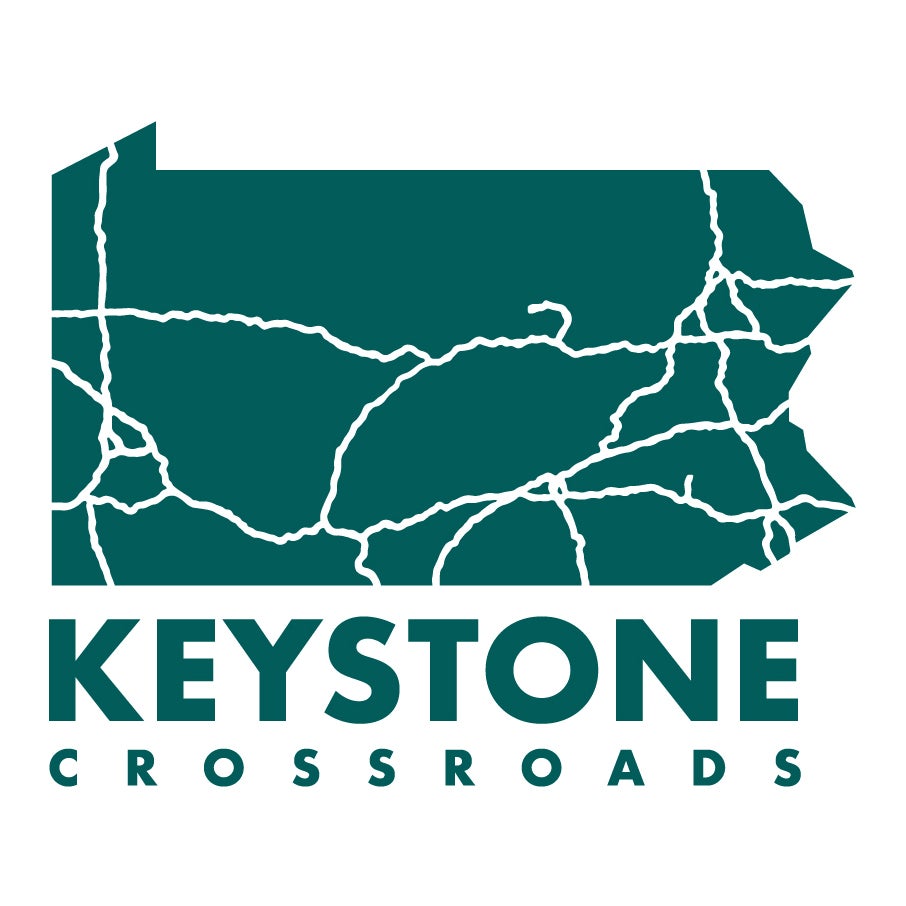
Get more Pennsylvania stories that matter
What is the greatest concern?
Short answer: protecting adults.
The recommendations made by Rubin’s team are largely designed to protect adults from contracting the coronavirus and to combat the type of disease spread thought to be most common among children.
As we know, children aren’t at particularly high risk for COVID-19.
Much of the strategy, therefore, is geared toward protecting adults who work in school buildings and protecting adults who take care of children.
The memo recommends plastic visors for teachers and flexible policies that allow older staff to remain home. The same flexibility is extended to children who live with elderly or immunocompromised caretakers.
Adults in schools pose two risks. Not only are they more likely to get the disease themselves, but experts say they’re more likely to develop respiratory symptoms, such as a bad cough. When an ill person starts coughing, it can lead to explosive, exponential spread.
Wearing a mask or visor can protect adults from getting sick, while also keeping their respiratory germs contained if they do have an undetected case of the coronavirus.
“The people at greatest risk … are the teachers and the staff,” said Rubin. “And those folks have to have their own set of hygiene and prevention. A lot of the testing needs to be focused on them.”
Children seem less prone to developing a coronavirus-related cough. The primary concern with kids is them spreading the disease through fomite transmission — meaning they leave germs on a surface, followed by someone touching that surface and eventually touching their face.
That’s why you’ll see a major focus on disinfection. Purell stations at every door, separate cubbies for all belongings, and strict hand-washing regimens are all geared toward preventing fomite spread.
All of that said, children are not immune from serious illness or death themselves. Scientists are still trying to understand a mysterious inflammatory syndrome linked to the coronavirus that seems to affect school-aged children. The ailment has killed three already in New York State and sickened over 100.
On a population level, the risk may be low — but it’s a risk policy-makers and parents will need to confront whenever students return to school.
“Everybody is somebody’s kid and every kid has some non-zero probability of becoming a severe case,” said Bharti from Penn State.
When does ‘normal’ return?
Short answer: We don’t know.
What we do know, experts say, is that widespread testing paves the road back to normalcy.
The absence of testing creates risk. Without it, health officials don’t know how well an intervention is working and can’t immediately know if another outbreak has begun.
It becomes easier to peel back safety measures when scientists are confident they can quickly track — and tamp down — any viral flare up.
In Germany, for instance, some newly reopened schools are testing students twice a week on a trial basis. The data from that pilot should help scientists understand transmission rates within school and corral any potential outbreaks.
“I think the key is testing within the school environment itself, but also really aggressive testing outside the school environment so we can feel confident that a low case number is real — that it truly reflects low transmission within the community,” said Chernak from Drexel.
Krys Johnson from Temple would like to see community spread near zero before schools reopen — essentially a scenario where health officials can track the origin of individual cases. She doesn’t think Philadelphia will have hit that benchmark by early autumn.
Rubin, from CHOP, doesn’t have a firm epidemiological threshold he’d like areas to meet before schools return. His focus is more on testing capacity.
“I’d like to see strong surveillance and testing in place,” he said. “[That way], should there be a resurgence, you can quickly identify it.”
Bharti agrees that testing capacity is crucial. She’s worried, however, about the ability to create widespread testing in parts of the state where medical infrastructure tends to be thinner.
“The scaling up and strengthening of health systems is definitely not favorable for rural areas,” said Bharti.
After being criticized by GOP leaders such as Turzai for suggesting that schools could remain closed into the fall, Pennsylvania Secretary of Education Pedro Rivera clarified that he believes schools will open when the next school year begins.
“The Department of Education fully expects students to return to school in the fall in some capacity and is currently developing a plan to help guide schools as they prepare for the new academic year,” the department said in a statement.
“In some capacity” is where the mystery lies — a mystery bound up in logistics, resources and the ongoing vagaries of a new and deadly disease.
WHYY is your source for fact-based, in-depth journalism and information. As a nonprofit organization, we rely on financial support from readers like you. Please give today.





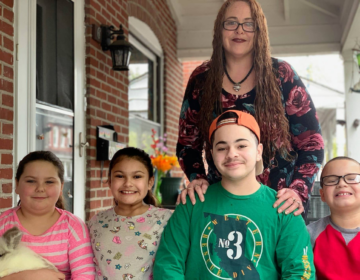
![CoronavirusPandemic_1024x512[1]](https://whyy.org/wp-content/uploads/2020/03/CoronavirusPandemic_1024x5121-300x150.jpg)
